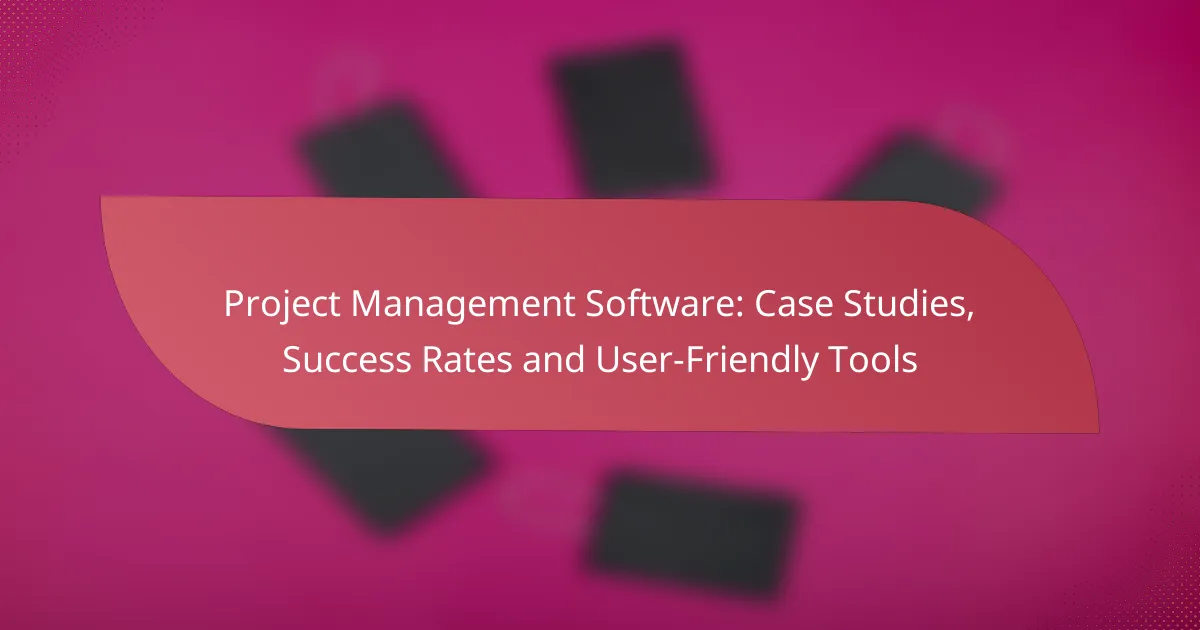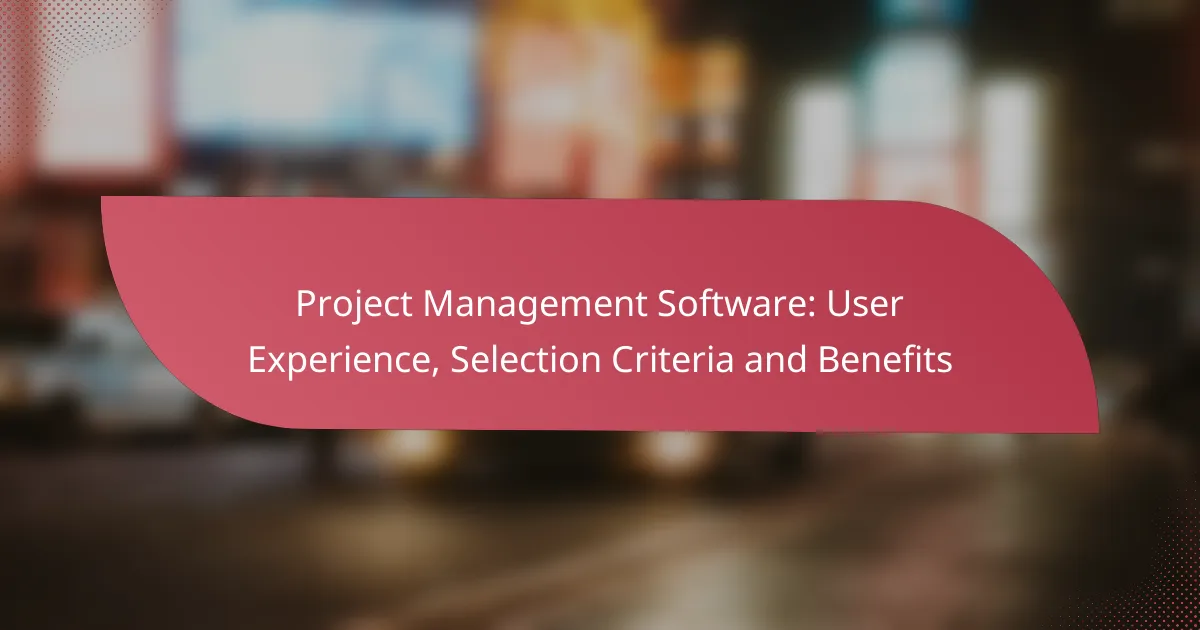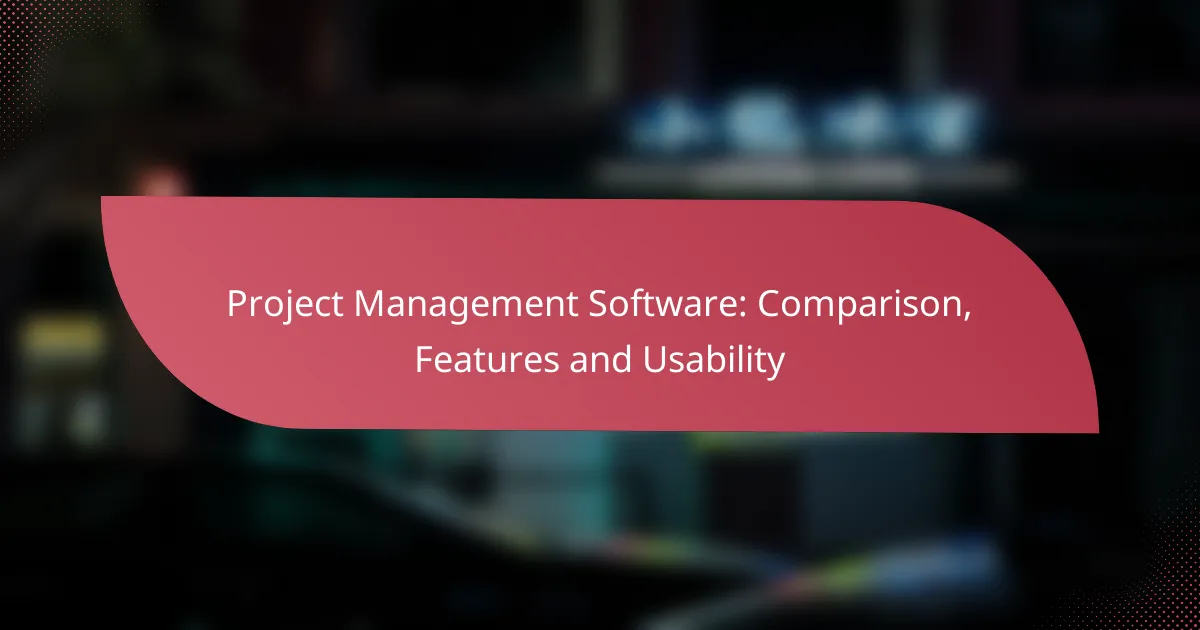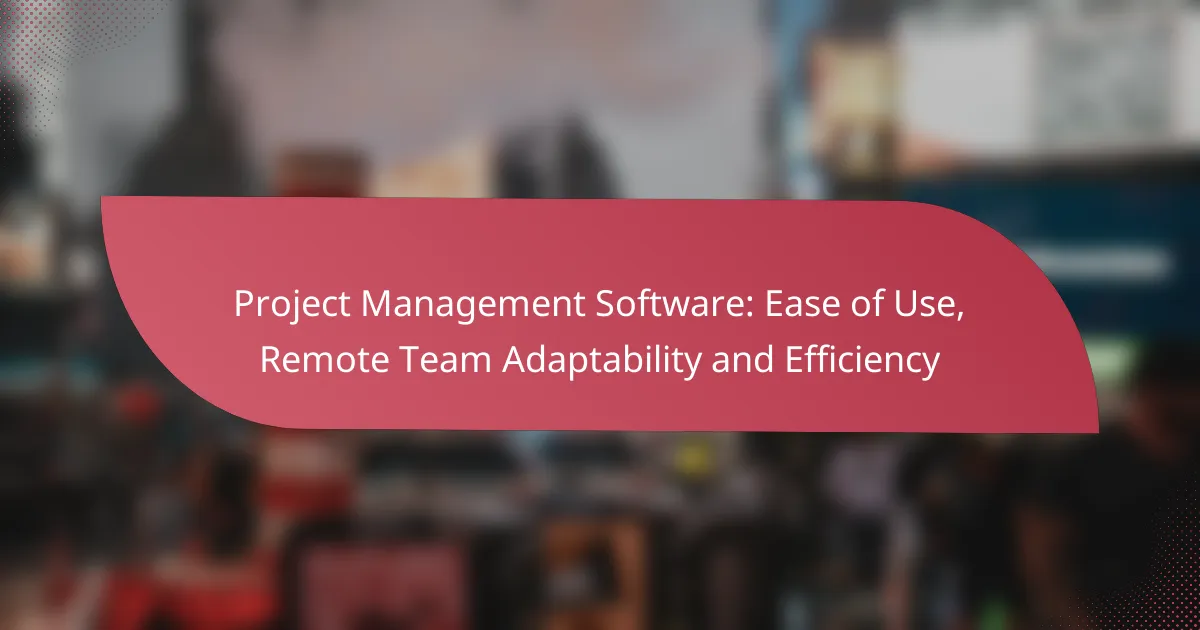Project management software plays a crucial role in enhancing team collaboration and productivity by offering user-friendly tools designed for seamless task management and communication. With features that prioritize ease of use, these platforms can significantly improve project success rates, often achieving between 70-90% effectiveness when adopted properly. By centralizing workflows and providing real-time updates, organizations can foster a more transparent and accountable working environment.

Which project management software tools are most user-friendly?
User-friendly project management software tools prioritize ease of use and intuitive interfaces, making them accessible for teams of all sizes. Key features often include simple task management, collaboration options, and customizable workflows that enhance productivity without steep learning curves.
Trello
Trello is known for its visual approach to project management, using boards, lists, and cards to organize tasks. Its drag-and-drop functionality allows users to easily move tasks through different stages, making it ideal for teams that prefer a straightforward, visual layout.
Consider using Trello for small to medium-sized projects where team collaboration is essential. The free version offers ample features, but larger teams may benefit from premium plans that provide advanced integrations and automation options.
Asana
Asana combines task management with project tracking, allowing users to create tasks, assign them to team members, and set deadlines. Its user-friendly interface supports both list and board views, catering to different project management styles.
Asana is well-suited for teams that require detailed project tracking and reporting. The basic version is free, but upgrading to a premium plan unlocks features like timeline views and advanced search capabilities, which can enhance project oversight.
Monday.com
Monday.com offers a highly customizable platform that allows teams to tailor workflows to their specific needs. Users can choose from various templates and visual layouts, making it easy to adapt the tool to different project types.
This software is particularly effective for teams that manage multiple projects simultaneously. While it provides a free trial, ongoing use typically requires a subscription, which varies based on the number of users and features selected.
ClickUp
ClickUp is designed to consolidate project management tasks into a single platform, featuring task management, document sharing, and goal tracking. Its user-friendly interface allows for easy navigation and customization, accommodating various project methodologies.
Teams looking for an all-in-one solution may find ClickUp beneficial. The free version offers many features, but premium plans provide additional functionalities like time tracking and advanced reporting tools.
Basecamp
Basecamp focuses on simplicity and team communication, providing a centralized space for project discussions, task assignments, and file sharing. Its straightforward design minimizes distractions, making it easy for teams to stay focused on their objectives.
This tool is ideal for teams that prioritize collaboration over complex project management features. Basecamp operates on a flat pricing model, which can be cost-effective for larger teams, as it charges a single fee regardless of the number of users.

What are the success rates of project management software?
The success rates of project management software can vary widely, often influenced by factors such as user adoption, project complexity, and the specific features utilized. Generally, organizations report improved efficiency and project outcomes, with many achieving success rates in the range of 70-90% when using these tools effectively.
Success metrics overview
Success metrics for project management software typically include project completion rates, adherence to deadlines, budget management, and stakeholder satisfaction. Organizations often track these metrics to evaluate the effectiveness of their chosen software and its impact on project outcomes.
Commonly used metrics include the percentage of projects completed on time, the average variance from budget, and user engagement levels. By analyzing these metrics, teams can identify areas for improvement and optimize their project management processes.
Case study: Trello
Trello is known for its user-friendly interface and flexibility, making it a popular choice for teams of all sizes. Many users report a significant increase in productivity, with some organizations noting a 30-50% improvement in task completion rates after implementing Trello.
One notable case involved a marketing team that used Trello to streamline their campaign planning. By visualizing tasks on boards, they reduced project turnaround time by approximately 40%, showcasing how effective project management software can enhance collaboration and efficiency.
Case study: Asana
Asana offers robust features for tracking tasks, deadlines, and team collaboration, leading to notable success rates among its users. Companies using Asana often report improved project visibility and accountability, with completion rates rising by around 20-30% in many cases.
A technology firm utilized Asana to manage product development cycles, resulting in a 25% reduction in time spent on status meetings. This case illustrates how Asana can help teams focus on execution while minimizing administrative overhead, ultimately driving better project outcomes.

How can project management software improve team collaboration?
Project management software enhances team collaboration by providing a centralized platform for communication, task management, and real-time updates. This leads to improved transparency and accountability among team members, fostering a more cohesive working environment.
Real-time updates
Real-time updates allow team members to stay informed about project progress and changes as they happen. This feature minimizes delays caused by outdated information and ensures everyone is aligned on current tasks and deadlines.
For instance, when a task is completed or a deadline is adjusted, all team members receive immediate notifications. This can significantly reduce the time spent in meetings or email exchanges, streamlining workflows.
Task assignments
Task assignments enable project managers to allocate responsibilities clearly and efficiently. By assigning tasks within the software, team members can see their individual workloads and deadlines, which helps prioritize their efforts.
Using a visual task board, such as Kanban, can further enhance clarity. Team members can drag and drop tasks between different stages, providing a quick overview of project status and individual contributions.
Integrated communication tools
Integrated communication tools facilitate seamless interaction among team members without leaving the project management platform. Features like chat, comments, and video calls help maintain discussions focused on specific tasks or projects.
Utilizing these tools can reduce reliance on external communication channels, ensuring that all relevant information is captured in one place. This not only enhances collaboration but also makes it easier to track decisions and discussions related to project progress.

What are the key features to look for in project management software?
Key features to consider in project management software include task tracking, reporting capabilities, and integration options. These functionalities help teams manage projects efficiently, monitor progress, and streamline workflows.
Task tracking
Task tracking is essential for monitoring project progress and ensuring that team members complete their assignments on time. Look for software that allows you to create, assign, and prioritize tasks easily, along with setting deadlines and reminders.
Consider tools that offer visual representations, such as Kanban boards or Gantt charts, to provide an overview of task statuses. This can help identify bottlenecks and allocate resources effectively, enhancing overall productivity.
Reporting capabilities
Robust reporting capabilities enable teams to analyze project performance and make data-driven decisions. Choose software that provides customizable reports on key metrics like task completion rates, resource allocation, and budget tracking.
Effective reporting tools should allow for real-time updates and easy sharing among team members and stakeholders. This transparency fosters accountability and helps in identifying areas for improvement.
Integration options
Integration options are crucial for ensuring that your project management software works seamlessly with other tools your team uses, such as communication platforms, file storage, and time tracking applications. Look for software that supports popular integrations to streamline workflows.
Consider the ease of integration and whether it requires additional setup or ongoing maintenance. A well-integrated system can save time and reduce errors, enhancing collaboration across different departments.

How do pricing models vary among project management tools?
Pricing models for project management tools can differ significantly, impacting how businesses budget for software. Common models include subscription-based pricing and freemium options, each with unique benefits and drawbacks that can influence user experience and cost-effectiveness.
Subscription-based pricing
Subscription-based pricing typically involves a monthly or annual fee for access to the software. This model often provides users with continuous updates, support, and a full range of features, making it suitable for teams that require reliable access to advanced tools.
Costs can vary widely, often ranging from around $10 to $50 per user per month, depending on the features included. Businesses should assess their needs and consider whether a tiered pricing structure aligns with their project management requirements.
Freemium models
Freemium models offer basic features at no cost, with the option to upgrade to a paid plan for additional functionalities. This approach allows users to test the software before committing financially, making it appealing for small teams or startups with limited budgets.
However, while freemium tools can be a cost-effective solution, they may come with limitations such as reduced storage, fewer integrations, or restricted user access. Teams should evaluate whether the free version meets their needs or if the paid upgrades are necessary for effective project management.



